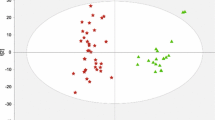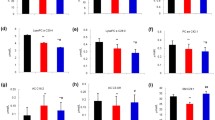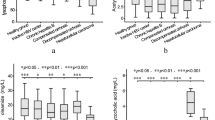Abstract
To improve the grading and staging of liver cirrhosis among patients with HBV infection noninvasively, a high-performance liquid chromatography with mass spectrometry metabolomics method was used to investigate the potential metabolic biomarkers in the serum of patients with different degrees of hepatic cirrhosis. The results demonstrate that lysophosphatidyl choline (LPC) from positive electrospray ionization (ESI) mode, and fatty acids and bile acids from negative ESI mode play important roles in distinguishing decompensated from compensated cirrhosis. A total of 21 differential metabolites were found from the two groups of patients. LPCs, fatty acids, and taurocholic acid (TCA) 3-sulfate decreased in patients with decompensated cirrhosis, whereas other bile acids increased significantly. The levels of TCA 3-sulfate, LPC 16:0, and LPC 18:0 were significantly correlated with the stages of the decompensated cirrhosis, and they may serve as potential biomarkers for the stage assessment of liver cirrhosis in patients with HBV infections.





Similar content being viewed by others
Abbreviations
- HPLC–MS:
-
High Performance liquid chromatography–mass spectrometry
- HBV:
-
Hepatitis B virus
- HCV:
-
Hepatitis C virus
- LPC:
-
Lysophosphatidyl choline
- ESI:
-
ElectroSpray Ionization
- GC–MS:
-
Gas chromatography–mass spectrometry
- RP-LC:
-
Reversed phase-liquid chromatography
- HILIC:
-
Hydrophilic interaction chromatography
- HCC:
-
Hepatocellular carcinoma
- CTP:
-
Child-turcotte-pugh
- MDC:
-
Mild to moderate decompensated cirrhosis
- SDC:
-
Severe decompensated cirrhosis
- RSD:
-
Relative standard deviation
- PCA:
-
Principal component analysis
- PLS-DA:
-
Partial least squares-discriminant analysis
- LPC:
-
Lysophosphatidyl choline
- LPE:
-
Lysophosphatidylethanolamine
- FFA:
-
Free fatty acid
- Stearic acid:
-
FFA 18:0
- Arachidonic acid, AA:
-
FFA 20:4
- Docosahexaenoic acid, DHA:
-
FFA 22:6
- TCA:
-
Taurocholic acid
- AST:
-
Aspartate aminotransferase
- ALT:
-
Alanine aminotransferase
References
Amathieu, R., Nahon, P., Triba, M., et al. (2011). Metabolomics approach by 1H NMR spectroscopy of serum for the assessment of chronic liver failure in patients with cirrhosis. Journal of Proteomic Research, 10(7), 3239–3245.
Arendt, B. M., Mohammed, S. S., Aghdassi, E., et al. (2009). Hepatic fatty acid composition differs between chronic hepatitis C patients with and without steatosis. Journal of Nutrition, 139(4), 691–695.
Cao, H., Huang, H., Xu, W., et al. (2011). Fecal metabolome profiling of liver cirrhosis and hepatocellular carcinoma patients by ultra performance liquid chromatography-mass spectrometry. Analytica Chimica Acta, 691(1–2), 68–75.
Chen, J., Zhao, X., Fritsche, J., et al. (2008). Practical approach for the identification and isomer elucidation of biomarkers detected in a metabonomic study for the discovery of individuals at risk for diabetes by integrating the chromatographic and mass spectrometric information. Analytical Chemistry, 80(4), 1280–1289.
Eriksson, L., Johansson, E., Kettaneh-Wold, N., & Wold, S. (2001). Multi- and Megavariate Data Analysis (pp. 43–56). Sweden: Umetrics Academy.
Gao, H., Lu, Q., Liu, X., et al. (2009). Application of 1H NMR-based metabolomics in the study of metabolic profiling of human hepatocellular carcinoma and liver cirrhosis. Cancer Science, 100(4), 782–785.
Gika, H. G., Theodoridis, G. A., Wingate, J. E., & Wilson, I. D. (2007). Within-day reproducibility of an HPLC-MS-based method for metabonomic analysis: application to human urine. Journal of Proteome Research, 6(8), 3291–3303.
Libert, R., Hermans, D., Draye, J. P., Van, H. F., Sokal, E., & de, H. E. (1991). Bile acids and conjugates identified in metabolic disorders by fast atom bombardment and tandem mass spectrometry. Clinical Chemistry, 37(12), 2102–2110.
Liu, J., & Fan, D. (2007). Hepatitis B in China. Lancet, 369(9573), 1582–1583.
Makarov, V.K. (2003). Phospholipids in blood serum and the differential diagnosis of chronic hepatitis B and the cirrhotic stage of the disease. Kliniceskaja Laboratornaja Diagostika, Feb; (2): 41–42.
Makarov, V. K. (2004). Phospholipid spectrum of blood serum in diagnostic of different stages of combined hepatic viral-alcoholic damage. Biomeditsinkaia Khimila, 50(5), 498–501.
Mannack, G., Graf, D., Donner, M. M., et al. (2008). Taurolithocholic acid-3 sulfate impairs insulin signaling in cultured rat hepatocytes and perfused rat liver. Cellular Physiology and Biochemistry, 21(1–3), 137–150.
Mills, K. A., Mushtaq, I., Johnson, A. W., Whitfield, P. D., & Clayton, P. T. (1998). A method for the quantitation of conjugated bile acids in dried blood spots using electrospray ionization-mass spectrometry. Pediatric Research, 43(3), 361–368.
Mushtaq, I., Logan, S., Morris, M., et al. (1999). Screening of newborn infants for cholestatic hepatobiliary disease with tandem mass spectrometry. British Medical Journal, 319(7208), 471–477.
Pan, P. H., Lin, S. Y., Ou, Y. C., et al. (2010). Stearic acid attenuates cholestasis-induced liver injury. Biochemical and Biophysical Research Communications, 391(3), 1537–1542.
Rockey, D. C., Caldwell, S. H., Goodman, Z. D., Nelson, R. C., & Smith, A. D. (2009). Liver biopsy. Hepatology, 49(3), 1017–1044.
Saadeh, S., Cammell, G., Carey, W. D., Younossi, Z., Barnes, D., & Easley, K. (2001). The role of liver biopsy in chronic hepatitis C. Hepatology, 33(1), 196–200.
Shimada, T., Nakanishi, T., Toyama, A., et al. (2010). Potential implications for monitoring serum bile acid profiles in circulation with serum proteome for carbon tetrachloride-induced liver injury/regeneration model in mice. Journal of Proteome Research, 9(9), 4490–4500.
Shiraishi, K., Matsuzaki, S., Itakura, M., & Ishida, H. (1996). Abnormality in membrane fatty acid compositions of cells measured on erythrocyte in alcoholic liver disease. Alcoholism: Clinical and Experimental Research, 20(1), 56A–59A.
Soga, T., Sugimoto, M., Honma, M., et al. (2011). Serum metabolomics reveals gamma-glutamyl dipeptides as biomarkers for discrimination among different forms of liver disease. Journal of Hepatology, 6(8), e23641.
Song, B. J., Moon, K. H., Olsson, N. U., & Salem, N., Jr. (2008). Prevention of alcoholic fatty liver and mitochondrial dysfunction in the rat by long-chain polyunsaturated fatty acids. Journal of Hepatology, 49(2), 262–273.
Tsukada, N., Azuma, T., & Phillips, M. J. (1994). Isolation of the bile canalicular actin-myosin II motor. Proceedings of the National Academy of Sciences of the United States of America, 91(15), 6919–6923.
Xue, R., Dong, L., Wu, H., Liu, T., Wang, J., & Shen, X. (2009). Gas chromatography/mass spectrometry screening of serum metabolomic biomarkers in hepatitis B virus infected cirrhosis patients. Clinical Chemistry and Laboratory Medicine, 47(3), 305–310.
Yang, J., Zhao, X., Liu, X., et al. (2006). High performance liquid chromatography-mass spectrometry for metabonomics: potential biomarkers for acute deterioration of liver function in chronic hepatitis B. Journal of Proteome Research, 5(3), 554–561.
Yin, P., Wan, D., Zhao, C., et al. (2009). A metabonomic study of hepatitis B-induced liver cirrhosis and hepatocellular carcinoma by using RP-LC and HILIC coupled with mass spectrometry. Molecular Biosystems, 5(8), 868–876.
Acknowledgments
This study was supported by National Basic Research Programme 973 of China (No. 2007CB513000), the State Key the State Key Science & Technology Project for Infectious Diseases (No. 2008ZX10002-017, No. 2008ZX10002-019), and the National Natural Science Foundation of China (No. 81000760).
Author information
Authors and Affiliations
Corresponding authors
Additional information
Yu Chen and Zhiliang Xu are contributed equally.
Rights and permissions
About this article
Cite this article
Chen, Y., Xu, Z., Kong, H. et al. Differences between the metabolic profiles of decompensated and compensated cirrhosis patients with Hepatitis B virus infections under high-performance liquid chromatography-mass spectrometry. Metabolomics 8, 845–853 (2012). https://doi.org/10.1007/s11306-011-0379-z
Received:
Accepted:
Published:
Issue Date:
DOI: https://doi.org/10.1007/s11306-011-0379-z




